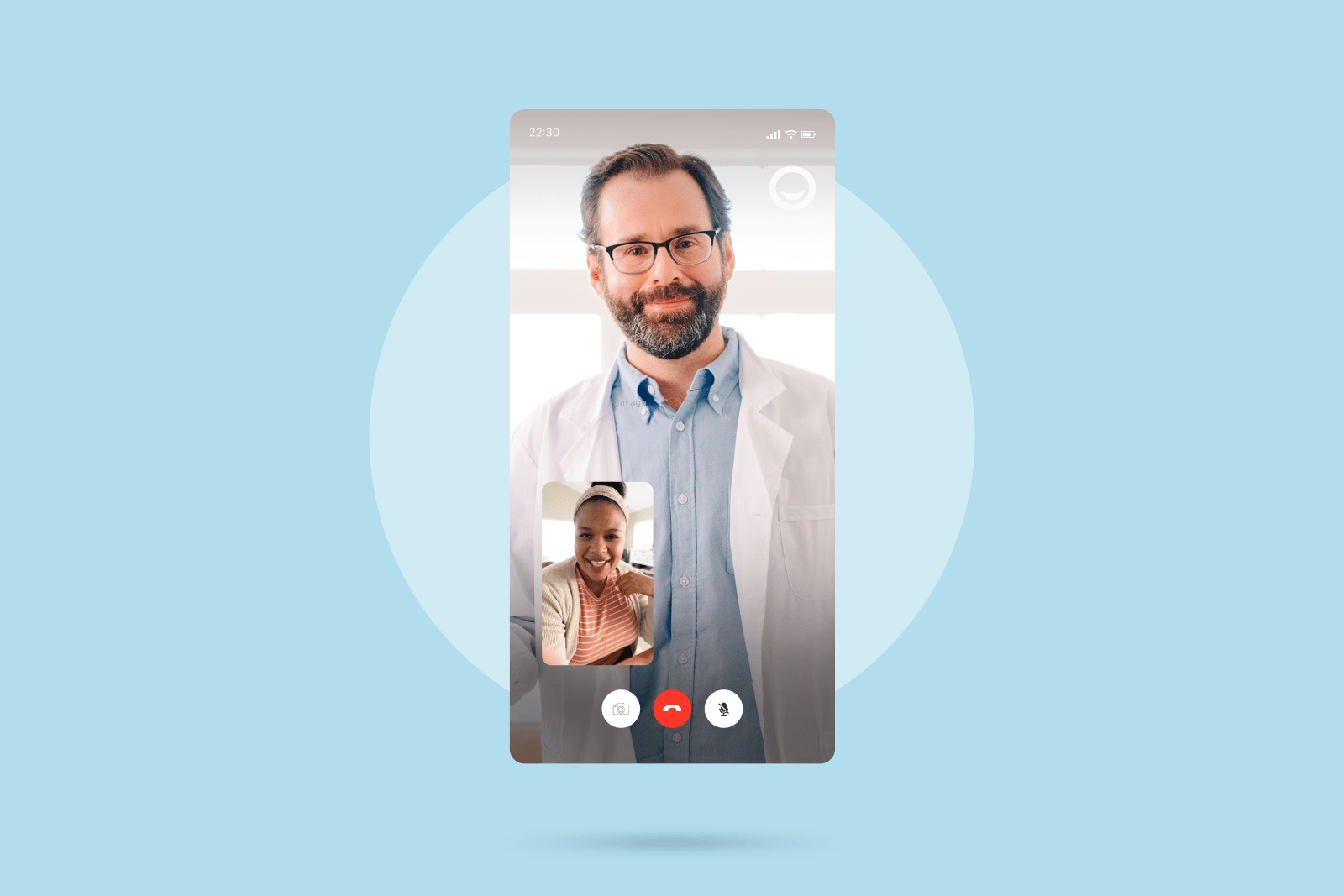
Cellulitis management available online today
Request a consult for cellulitis management online from our trusted, board-certified primary care doctors and find relief from swelling and pain. Get a new prescription to treat cellulitis or refill an existing prescription today.*

*Prescriptions are provided at the doctor's discretion. Learn more about our controlled substances policy and how to save up to 80% with our prescription discount card. PlushCare doctors cannot treat all cases of cellulitis, as some cases require in-person specialist or emergent care. Also, not all skin conditions may be cellulitis and may require in-person care for diagnosis. Our primary care physicians can conduct an initial evaluation of your symptoms but may need to refer you to a specialist or for in-person treatment. If you are experiencing life-threatening symptoms, seek emergency medical attention immediately.
Learn about cellulitis
Without proper treatment, cellulitis can spread to other parts of the body, leading to serious complications.
Cellulitis causes
Cellulitis is usually caused when bacteria enter a wound.
The most common cause of cellulitis is group A Streptococcus, or "group A strep." Other types of bacteria, such as Streptococcus pneumoniae and Staphylococcus aureus (Staph), including Methicillin Resistant Staphylococcus Aureus (MRSA) can also cause cellulitis.
In healthy people, staph and strep bacteria are commonly found on the skin and mucous membranes of the mouth and nose. However, a bacterial infection can happen when there's a break in the skin that allows bacteria to enter. Other causes include:
-
Human or animal bites
-
Injuries that happen in water
-
Damaged skin due to wounds, cuts, or surgical incisions
Cellulitis symptoms
The symptoms of cellulitis can vary from person to person, and each person may experience symptoms differently. Some common symptoms include:
-
Redness, tenderness, or swelling of the skin
-
Bruising and blisters in the affected area
-
Warm skin
-
Pain
-
Fever
-
Chills
-
Weakness
Although cellulitis can occur anywhere on the body, the lower legs are the most common infection sites. Bacteria are more likely to enter broken, dry, or swollen skin. Your risk of developing cellulitis may be higher if you have:
-
Open wounds, such as ulcers, puncture wounds, surgical incisions, tattoos, or piercings
-
Chronic skin conditions, such as athlete's foot or eczema
-
A weakened immune system
How to treat cellulitis
In most cases, cellulitis treatment includes prescription oral antibiotics or antibiotic ointment. Within 3 days of starting antibiotic treatment, let your health care provider know whether the skin infection is responding to treatment. Even if the bacterial infection improves, it's important to continue taking antibiotics for the full course of treatment.
Most symptoms improve within a few days of starting antibiotic treatment. However, severe cellulitis may require hospitalization and intravenous (IV) antibiotics, as noted by symptoms such as fever >100.5°F, rapid spread (for example, doubling in size within 24h), or widespread erythema (redness).
Cellulitis medication
How to prevent cellulitis
Cellulitis typically affects damaged skin, but it can also affect areas with poor hygiene. To help prevent cellulitis, take the following precautions:
-
Wash your hands regularly with warm water and soap
-
Clean and trim your fingernails and toenails
-
Thoroughly dry your skin after showering
-
Keep open wounds clean and apply antibiotic ointment
-
Cover open wounds with bandages
When to see a doctor for cellulitis
If you notice any symptoms of cellulitis, you should make an appointment with a doctor. In the early stages of soft tissue infections, your skin may look pitted or discolored.
Seek immediate medical attention if you experience:
-
Symptoms that don't respond to oral antibiotics within 48h
-
Numbness, tingling, or other changes
-
Large areas of skin swelling or inflammation
-
A fever >100.5°F
Related conditions to cellulitis
Gout
Gout, a skin condition that commonly occurs on the leg, may resemble cellulitis. Gout occurs when crystals form in a joint, which causes inflammation near the joint.
If you experience swelling, tenderness, or warmth, schedule an appointment with your doctor to diagnose cellulitis.
Cellulitis treatment FAQs
How long does cellulitis take to go away?
Most people experience symptom improvement within 48h of starting antibiotics, and resolution within 7–10 days. Severe bacterial infections may require a longer course of treatment, often with IV antiobiotics initially.
Even if your symptoms improve, it's important to continue taking your antibiotics as prescribed.
Is cellulitis contagious?
Cellulitis usually isn't contagious. In rare cases, people can develop contact cellulitis if they have an open skin wound and have skin-to-skin contact with an infected person's open wound.
What helps cellulitis heal faster?
Cellulitis requires treatment with antibiotics, which can be prescribed by a doctor. However, you can speed up your recovery with home remedies:
- Cover your wound with a clean bandage and apply a skin protectant
-
Elevate the affected limb to reduce swelling
-
Seek treatment for any underlying conditions, such as athlete's foot
-
Apply a clean washcloth soaked in cool water to relieve pain
What are the complications of cellulitis?
Untreated cellulitis can have serious health complications. Bacterial infections can cause extensive tissue damage and tissue death (gangrene).
The bacteria can also spread to the bloodstream, lymph nodes, or nervous system, causing a more serious infection called sepsis. These infections can lead to amputation, shock, or even death.
Can cellulitis go away on its own?
3 simple steps to request your cellulitis prescription today

Book a cellulitis treatment request appointment.
Book a same day appointment from anywhere.

Talk to your medical provider regarding your cellulitis symptoms.
Visit with a doctor on your smartphone or computer.

Pick up a prescription to treat cellulitis, if provided.
We can send prescriptions to any local pharmacy.
Cellulitis treatment pricing details
To request cellulitis treatment and get a new or refill on your prescription, join our monthly membership and get discounted visits.
30 days of free membership
- Same-day appointments 7 days a week
- Unlimited messages with your Care Team
- Prescription discount card to save up to 80%
- Exclusive discounts on lab tests
- Free memberships for your family
- Cancel anytime
Paying with insurance
Membership
$19.99 /month
First month free
Visits
Copay
Visit price with insurance
Often the same as an office visit. Most patients with in-network insurance pay $30 or less!
We accept these insurance plans and many more:



Paying without insurance
Membership
$19.99 /month
First month free
Visits
$129
Visit price without insurance
Cellulitis treatment resources
Sources:
PlushCare is dedicated to providing you with accurate and trustworthy health information.
-
Centers for Disease Control and Prevention. About Cellulitis. Accessed on June 18, 2024. https://www.cdc.gov/group-a-strep/about/cellulitis.html
-
John Hopkins Medicine. Cellulitis. Accessed on June 24, 2022. https://www.hopkinsmedicine.org/health/conditions-and-diseases/cellulitis
-
Mayo Clinic. Cellulitis. Accessed on June 24, 2022. https://www.mayoclinic.org/diseases-conditions/cellulitis/symptoms-causes/syc-20370762
PlushCare content is reviewed by MDs, PhDs, NPs, nutritionists, and other healthcare professionals. Learn more about our editorial standards and meet the medical team. The PlushCare site or any linked materials are not intended and should not be construed as medical advice, nor is the information a substitute for professional medical expertise or treatment.